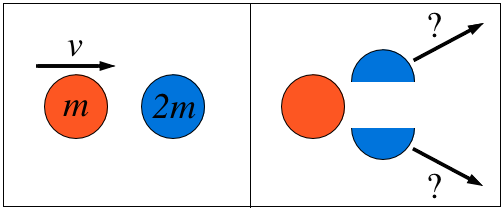Collide and break!

A body of mass is moving along the -axis with speed when it collides with a body of mass initially at rest. After the collision, the first body comes to rest and the second body splits into two pieces of equal mass that move with equal velocities at equal angles off the -axis , as shown in the figure.
Which of the following statements correctly describes the speeds of the two pieces?
This section requires Javascript.
You are seeing this because something didn't load right. We suggest you, (a) try
refreshing the page, (b) enabling javascript if it is disabled on your browser and,
finally, (c)
loading the
non-javascript version of this page
. We're sorry about the hassle.
Let's conserve momentum along the x -axis. Before the collision, the total momentum in the horizontal direction is m v . After the collision, the horizontal velocity of each piece is given by m v ′ cos θ , where v ′ is the velocity we're interested in. (Note, the lower piece makes an angle of − θ , but cos θ = cos ( − θ ) . )
As there are two such pieces, the total momentum is then 2 m v ′ cos θ which must be equal to m v by conservation:
m v = 2 m v ′ cos θ ⟶ 2 cos θ v = v ′
Since cos θ is never bigger than or equal to 1, it must be that the left hand side is larger than 2 v .